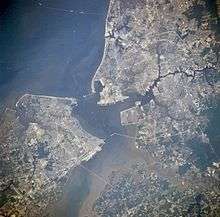Norfolk–Portsmouth Bridge–Tunnel
 (From left uppermost, going clockwise:) Hampton, Norfolk, Portsmouth, Suffolk, and Newport News, Virginia, USA. - July 1996 One can see the major roadways throughout Hampton Roads, starting from the top with the Chesapeake-Bay Bridge-Tunnel (it has three bridge spans and two tunnel spans, seen with the gaps). The next down is the Hampton-Roads Bridge-Tunnel, connecting Hampton and Norfolk. Going further down, one sees the Monitor-Merrimack Memorial Bridge-Tunnel, connecting the tip of Newport News (near Northrop Grumman - Newport News shipyard) to Suffolk. Continuing down the major river (the James River, to be exact), one sees the James River Bridge, a draw-bridge, also connecting Newport News with Suffolk. Another visible landmark is the Fort Monroe Military Installation, located directly next to the Hampton Roads Bridge-Tunnel. This is one of the oldest fortifications in the United States, and has been occupied at various times through its history by Gen. Robert E. Lee and famous author Edgar Allan Poe. During the Civil War, Fort Monroe remained unbeseiged by the Confederacy, because, according to rumor, Gen. Lee knew that the fort would not fall. It retains the old fortification design inherited from Great Britain and Europe, characterised by a central island surrounded by a moat. This photograph is rotated approximately 120 degrees clockwise from true north. Norfolk, Portsmouth, and Suffolk are all part of the "Southside". | |
| Overview | |
|---|---|
| Location | Norfolk, Virginia, United States |
| Route |
|
| Operation | |
| Opened | May 23, 1952 |
| Technical | |
| Number of lanes | 4 |
Coordinates: 36°50′9″N 76°17′16″W / 36.83583°N 76.28778°W The Norfolk–Portsmouth Bridge–Tunnel was a project to connect downtown Norfolk, Virginia, United States with downtown Portsmouth via a drawbridge over the Eastern Branch Elizabeth River and a tunnel under the Southern Branch. It opened on May 23, 1952, predating the area's better-known bridge–tunnel complexes: the Hampton Roads Bridge–Tunnel, opened in 1957; the Chesapeake Bay Bridge–Tunnel, opened in 1964; and the Monitor–Merrimac Memorial Bridge–Tunnel, opened in 1992.
Substantially rebuilt with the tunnel portion expanded to four lanes, the Norfolk–Portsmouth Bridge–Tunnel complex, which carries Interstate 264, is now more commonly known as its two parts:
- The Berkley Bridge
- The Downtown Tunnel
This article is issued from Wikipedia - version of the 9/7/2016. The text is available under the Creative Commons Attribution/Share Alike but additional terms may apply for the media files.